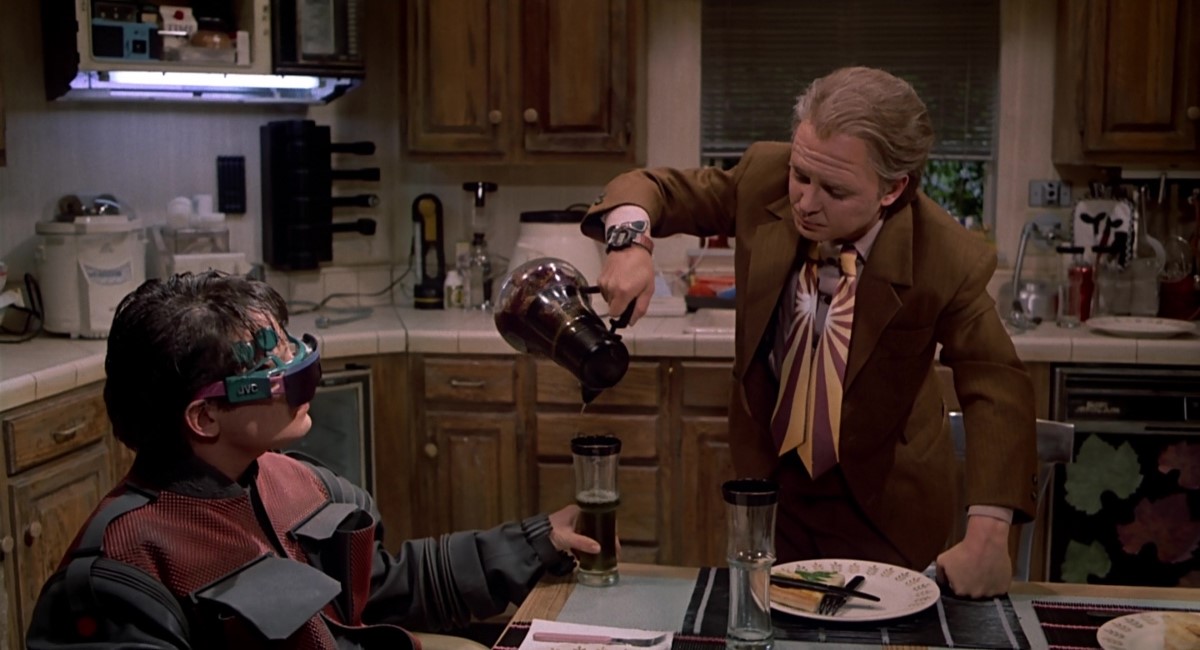by Pauline Kael
Back to the Future Part II is all manic and wacky. It’s all twists. The amiably mad inventor Doc Brown (Christopher Lloyd) rushes into the frame to tell teen-age Marty McFly (Michael J. Fox) about new emergencies in the year 2015 or 1955 or an alternate 1985 (brought about by their disrupting the space-time continuum), and they go hurtling off to set things right. I’ve never seen another movie in such a hurry or with so much shouting. Or maybe I have—Who Framed Roger Rabbit, which, like this one, was directed by Robert Zemeckis. But I found Roger Rabbit such a nightmare that I put it out of mind; it’s in a horrible genre all its own. Future II isn’t nightmarish; it’s sort of fun. But there’s no real zest in it. It’s more like a board game—or a video game—than a movie.
Zemeckis and his frequent writing partner Bob Gale are themselves obsessed mad inventors; they devise screwball-comedy contraptions that rival Doc Brown’s DeLorean time machine. Their script for Spielberg’s 1941 and their scripts that Zemeckis has directed—I Wanna Hold Your Hand, Used Cars, and the two Futures—are all marked by mechanical ingeniousness, but usually there’s a spark of boyish impetuousness, too. Their movies are jokes that get carried away with themselves and swallow the universe. You can feel the kinetic impulse to go too far that drives these pictures forward; you can share in it, and feel terrific. But Future II—which is the middle film of a trilogy—smacks of the assembly line. All our attention is focused on where Doc and Marty are in time, which of their multiple selves or their relatives they’re going to run into, and what the bullies Biff and Griff (both played by Thomas F. Wilson) are up to. The inventiveness seems to be on a treadmill in a void.
When Doc rushes onscreen (in 1985) and tells Marty that they have to go to 2015, because something has gone wrong with Marty’s children, it’s just a gimmick to get the picture off the ground; we barely get a look at “the children” (both played by Fox). Characters interact with themselves at different ages; they’re multiplied all over the place. But the only humor is in the special-effects multiplication processes (which probably account for the film’s looking so dark); there’s no ingenuity in the creation of the characters themselves. (Making the Marty of 2015 a business executive who’s a cringing loser goes against the grain of everything we’ve seen Fox do as the young Marty, and the movie seems rather offhand about making Marty’s son a wimpish twit.) There are no performances—except, maybe, in a nasty scene or two featuring Wilson’s young Biff—because the continuum is too speedy for acting. Marty’s girlfriend, Jennifer (Elizabeth Shue), is brought on board the time machine and then rendered unconscious and slung around like a sack of potatoes. Lea Thompson, who brought a dazed sexiness to the role of Marty’s mother-to-be in the first film, is now split into three selves, all of them blanks. Christopher Lloyd has just one real moment; it comes at the end—he evinces surprise and promptly faints.
Future II got made because, as the Universal publicity material puts it, “in its initial release, Back to the Future earned over $350 million worldwide, and emerged as the top grossing film of 1985.” Obviously, if Zemeckis and Gale had not agreed to make the sequels themselves their characters and conception would have been turned over to other hands. It’s no wonder that the film seems more hectic and more drab than the first. It doesn’t have anything like the first film’s what-the-hell Oedipal humor; maybe so much is at stake here that Zemeckis and Gale don’t feel the freedom to be funny—they’re caught in a machine-driven hysteria. The inventiveness is fast and furious, but low in spirit. Inventiveness has become a formula. And yet the construction keeps you going—it’s like a frenzied daydream that you don’t want to break off.
The New Yorker, December 11, 1989





